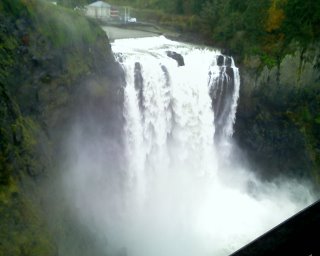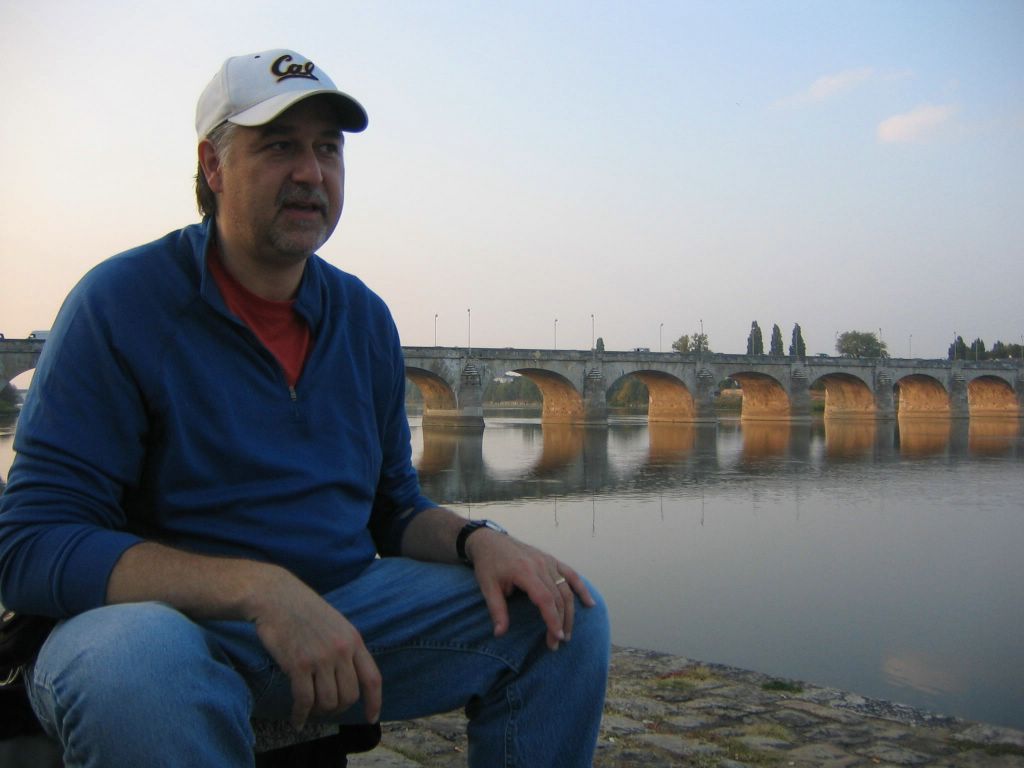Thursday, May 08, 2014
Wow... we still have a blog
This site has been dormant for too long. I can see the need to start posting longer form items that I can get onto Facebook.
One thing I will do with the first post is to put up a link to help one of my favorite Open Source software projects; Synergy. If you work at home and need to use your work laptop along side your home computer, this is a must have utility. http://synergy-project.org
Friday, May 29, 2009
A new food to cook on the grill; Pizza

- The crust on this pizza was very thin and crisp. More like a cracker on the bottom. The bottom was not burnt, only a few scorch marks. The top was pretty well cooked. The crust was pretty bland.


Sunday, May 24, 2009
Friday, January 30, 2009
New Workstation
One other add-on to the system is a device which allows me to send TV shows from my satellite box to any computer; Slingbox Solo (http://www.slingmedia.com/go/slingbox-solo). With this device, I can watch TV and change channels from my computer.

Monday, September 01, 2008
The Orange bike rolls...

I had to swap put the knobby tires I had used, they were just too wide to fit and they rubbed the chainstays in the back. I got a pair of big ole cruiser tires that are just great. I used mostly old parts from the original bike. The new parts added are;
- Seat; I pulled the Brooks B67 seat off my touring bike for this project.. this is a much better use for that seat. I replaced it on the Surly with a Brooks Flyer Special (which I just love on that bike)
- Brakes; I used a pair of Shimano Deore Linear pull V brakes that Dan had given me a while ago. They don't fit this bike as well as I'd like, but they do the job. I also needed to add a cheap pair of Linear pull Brake levers.
This bike will be my "run around town..." bike. I think I'm going to add a basket to the front, big enough to carry groceries and gyms stuff.

Saturday, August 09, 2008
This Old Bike

The old bike had fallen on hard times after years of neglect. I was ready to give it away on Craigslist twice before realizing what a nice frame it was and how much sentimental value there was with it.



So I stripped the frame down and had my local bike shop send it out to be stripped and powder coated. The results were amazing...




I'm now setting to work to rebuild it. The first pass I'm going to put it back together with as many of the old pieces. Later I'll begin swapping parts out.
Today I pulled both hubs apart, replaced the bearings and readjusted them..

Saturday, May 31, 2008
A cool web tool for mapping your ride/walk/hike
Here is a glimpse of a fantastic ride that Dan and I took on Memorial day. This ride heads up into the San Mateo hills and along the ride along the San Andreas fault zone.
Below is a look at the whole route.... to see the details, follow this URL: http://www.mapmyride.com/ride/united-states/ca/san-mateo/460094816206
Touring means carrying stuff...

I picked up my racks this week and installed them on the Surly. These are made by a German company called Tubus. They are lightweight steel racks capable of carrying 90pounds on the rear and 30 pounds on the front. The racks come with a warranty card that promises that if the racks break in the first three years, they will send a replacement to you via courier, anywhere in the world. (Click on any picture to see a larger version)

The Front racks are simple, light and very sturdy. They mount to both sides of the fork as well as to the dropout lugs.

Here are the front and rear racks on the bike

And here is a shot with my Ortlieb Classic Panniers mounted. I have rear bags, but not the smaller version designed for the fronts. I'll be watching Craigslist and Ebay for a used pair.

I love these panniers. They are essentially big waterproof bags, but they are really well made, they can hold a ton of gear and they have an ingenious latching mechanism for attaching to the rack. Dan used a pair of these when we rode in France a few years ago and I was sold. When we got back from that trip, I returned the REI bags I had been using and bought a pair of these

Saturday, May 24, 2008
The Mid-Life Crisis Bike

Some people get red sports cars, I got a blue Surly Long Haul Trucker. Here is a bit about my bike and a few pictures. (you can click on any picture to get a giant version)
The LHT is designed for Touring. It has a long wheelbase and a relatively laid back geometry. The frame is made from steel which is strong, flexible and (important if you are on a world tour in the middle of the Yukon) repairable by any welder. The back wheel sits on long chainstay's, resulting in more room for panniers behind your feet. The Framebuilder has also added lots of connection points for the racks and water bottles you'd want on a long tour.

I had a local shop build this bike from the frame up in order to get a few specializations I was interested in. One thing they did for me was to build the wheels by hand. This allowed me to get very sturdy rims and to build wheels with more spokes (36) than the norm. The result of this was to create very strong wheels. With the weight of gear added to my weight, broken spokes become a common occurrence.
Speaking of broken spokes... one of the cool little add-ons to the frame are these little Spare Spoke Holders built into the chainstay:
The label "Fatties Fit Fine" is referring to the spacing for large tires, not to the rider.

The other thing I did with the wheels, was to have the shop use a Shimano Generator hub in the front wheel. This little gadget will convert my motion into 3 Watts of electricity to power lights. There is almost no noticeable friction from the hub. The little grey block on the right is where the wires will connect (I still need to get the light)

The gear shifters for this bike are ingenious, they are built into the brake levers.
To shift one direction you push the small black levers toward the wheel, to shift the other way you push the whole silver lever in. It takes a little getting used to, but is is amazingly convenient when riding.

For riding the long haul, I added a Brooks Leather Saddle with springs. This has been a great addition, it was really comfortable from the first ride. As I've gotten the saddle broken it it has improved (though there is an annoying squeak I need to take care of).

I gave up trying to fit my size 13s into those stupid little toe clips and I refused to have to wear special shoes everytime I ride (I use this bike to ride to work almost every day). I added these monster platforms. They have lots of little grabbers on the decks and my feet stick in these almost as well as if I had toe clips.

Lastly, I added a rear cassette with 10 gears. The result of this is a really smooth progression of gears. As you climb a hill you can drop down just enough to keep your legs working.
Saturday, June 09, 2007
What is P2P and why is it the best and worse thing to happen to the Internet
People who know how these papers work know that instead, one electronic copy of that paper is sent to a local printer in Washington and thousands of copies are printed locally and delivered to homes quickly. This model also exists on the internet today and is called the "Content Distribution Network" model. When you watch that youtube video or download that iTunes music, you are actually retrieving a copy that is stored on a server that may be very close to you, This saves all kinds of bandwidth and is a necessecity for those companies like Microsoft, Google, Apple and others who send lots of data. The comanies who provide this service are wildly profitable and get away with charging alot for their services. Yesterday one of these companies (Limelight Networks) went public and their stock was bid up almost double in the first hours of trading.
Returning to the newspaper analogy for a minute, suppose all of us and our neighbors had a printing press in our houses and were able to download and print the Times. While we were doing this, our neighbors were also downloading the paper. If we knew we needed the sports and business section, and our neighbor had them, it would be much better for us to get those sections from them rather than downloading them from a server far away. Imagine we has hudreds of neighbors all offering a page of the paper as soon as they get it, and you will begin to understand Peer to Peer (or P2P). Today this technology is wildly popular among the music and video sharing folks. If you connect to the "bittorrent" P2P network, you can download virtually any music, TV, Movie or software you can imagine. These files are all stored on your neighbors coputers and you pull a small bit from each of them. Sharing uses a small bit of their network connection in the "up" direction, but most of us use very little of that bandwidth today; if you are like me, the only up traffic is the clicks you make to request web pages and the emails you send out. All the other traffic is in the down direction.
Today, P2P protocols are uncrontrolled and you don't really share only with your close neighbors... you are sharing with a vast group of "neighbors" all over the world. The result is that traffic doesn't stay in your neighborhood, but it bounces all across the network. According to studies, almost 60% of the traffic on the Internet backbone trunks is P2P file sharing, and most of that is video. This is more than all the email and web browsing traffic combined! And this is really being generated by a small set of the Internet users (i.e. Bittorrent users). Imagine what the world looks like when the old folks start using P2P.... the net will be crushed.
What is needed is a managed P2P that can ensure that local traffic is really delivered locally. It would also be great if the applications could make effective use of their neighbors to ensure fast reliable delivery. Add onto that the ability for content producers to protect their content (i.e. you can't share that movie you bought with someone who didn't buy it), support realtime live video and the ability to insert targeted ads and you'll see what Rinera Networks is setting out to build.
Monday, March 19, 2007
Cool... Compressed Air Car - 200 Km on a fill
Hmmm... perhaps this is how 1 billion Chinese will get behind the wheel...
Sunday, March 18, 2007
The worlds smallest mountain range
The valley route follows the Sacremento River from it's headwaters (in the town of Mount Shasta) and passes sheep and cow ranches, nut trees, olive trees, fruit orchards and miles and miles of the most fertile rice paddies in the US. This time driving down the sky was filled with smoke from the seasonal burning of the rice fields.
As you look east across these fields you can see the smallest mountain range in the world, the Sutter Buttes. Last week the NY Times ran an article about these hills and the efforts to create a state park around them ( they are completely private owned today). The article tells about the volcanic upwelling that created the range independant of the Sierra or Coastal mountain ranges.
Saturday, March 17, 2007
Social Networks and the "Luck Factor"
There are a number of other sites attempting to do similar things; linking people together based upon sports or music or politics. This is part of what people are calling "Web 2.0"; the ability to use the network infrastructure to tie people and information more closely together.
The other social networking site that I make most use of is called Linked In. This site allows me to connect and maintain contact with people I've worked with at previous jobs. It is useful as a Rolodex because when a person changes jobs or email addresses their updates are automatically published to all their contacts. For people like me who are job hunting, there are two great aspects to the site; Recommendations and Introductions. LinkedIn gives me a place to record and publish recommendations from colleagues. If you take a look at my Linked In Profile you will see a number of recommendations that I've gotten; in one step I can point prospective employers to these. Using the Introduction tools, when I have a position I am interested in, I can search LinkedIn for people who work at that company (preferably someone like the VP of Ops in my case) and see if anyone in my network of contacts knows that person (and would be willing to make an introduction).
I'm currently reading a book called The Luck Factor: The Four Essential Principles which attempts to break down the elements of what people characterize as a "Lucky" life. The premise is that luck is not some sort of supernatural blessing, but it is the result of actions, both conscious and unconscious. This premise made complete sense to me; Looking back on the times when I've made lucky or fortunate choices, there was really much more planning, thought and intuition involved than "luck"
The author is a psychologist and studies a population of people who characterized themselves as either Lucky or Unlucky. To make a long story short, he distilled his observations down to this; Lucky people are generally Open, Extroverted and Relaxed (as opposed to neurotic) which results in more opportunities to build and stay connected with a large network of friends, to be open to new opportunities and be relaxed and confident enough to recognize the opportunities and take them.
The first principal he identifies is that "Lucky" people build and maintain a large and vital network which is the first step on the road to "luck". In reading this, the comparisons to LinkedIn and the functions it fills were obvious. Building and maintaining a healthy network of connections is one of the building blocks to a "lucky" break.
Tuesday, February 27, 2007
Buggy Whips and VHS rewinders
Sunday, February 25, 2007
Photoshop is pretty cool...
Here is a "before" image (click on this to give a a large view):

In Photoshop I tuned down the brightness of the image and cleaned up the white scratches. This was a tricky image because of the scratches on on her eye. Essentially you can edit pixel by pixel to recreate what was lost. It took about 15 minutes to fix this (the original is a much bigger picture and it was in bad shape)

Some notes on the scanner (Epson Perfection V700 Photo Color Scanner
I should note that the scanner has tools built into it to automatically do much of this scratch removal (called Digital ICE). I've used this a bit, but found that the results were not as good as I could achieve manually.
Sunday, February 18, 2007
Why I'm moving my pictures over to Flickr
- I can't download pictures to use on my computer. Perhaps I
want to print one of Kevin's picture or use it in a card or
document, I can't do that
- I can't link to my OFoto pictures from somewhere else. In
order to see my pictures you need to log in, there is no other
interface for getting access to the image (what computer guys call
an API...)
- Because of the issues listed above, I am stuck viewing pictures
in that limited OFoto interface (and the pictures are too small to
really enjoy)
There is a photo sharing site called flickr.com that has become really popular, particularly because they fix exactly the problems called out above. I've been playing around with what it can do and I wanted to share it with you.
- First, take a look at my flickr site (http://flickr.com/photos/steveandsue/)
- Then click on any picture (here's one to try http://flickr.com/photos/steveandsue/394335199/)
- Then look at the largest view of that picture: (http://flickr.com/photo_zoom.gne?id=394335199&size=l)
That rocks... I can also link to any of the size images directly from an email or blog and they let you download the large size right from that last page.
That's pretty cool, but the best part of Flickr is the API that they have developed. Because they are so open with sharing pictures, hundreds of programs are available to link in and use the pictures... If you go to my blog (http://stedanrac.blogspot.com/) you can see one example called a "badge" that rotates through the pictures.
But that isn't the coolest thing... If you do one tech thing this week, download and install this screensaver (note to Rachel... there is a Mac version there also). When you get it installed, you can point it to a set of flickr pictures. Posted below here is a detailed instruction page to help. Believe me, it is really cool and worth installing...
How to configure Mosaica screensaver
First, here is a link to the detailed instructions on how to install and configure Mosaica screensaver: http://blog.consta.de/mosaica/options/
To configure it to see my Flickr pictures, go into the screensaver config:
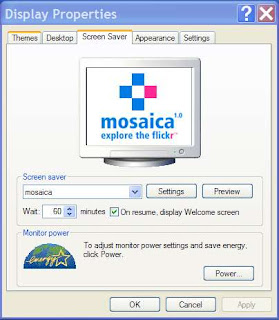
Click on the "Settings" button and enter steveandsue in the "User:" box as shown below
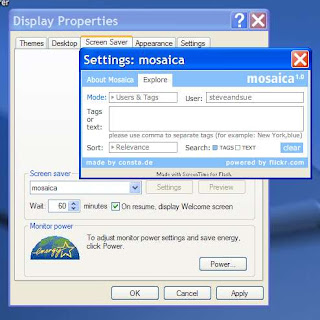
Futher options can be added by entering specific tags in the configuration. For example, if Rachel wanted to have a screensaver with only pictures of her, she could enter "Rachel" in the tags box
Saturday, February 17, 2007
Whistling Past The Graveyard
Here is a quite from a somewhat upbeat article in yesterday's Seattle Times (Full text here).
WASHINGTON — The slump in housing deepened in the final three months of last year, with sales of existing homes falling in 40 states and median prices dropping in nearly half the metropolitan areas surveyed.
Although Washington state's sales of houses and condominiums declined 16 percent, prices continued to climb, thanks to a generally strong economy.
In the Seattle-Tacoma-Bellevue area, prices rose 11.3 percent in the fourth quarter compared with a year earlier, the National Association of Realtors reported Thursday. Spokane prices were up 12.2 percent, and Portland up 11.2 percent.
Formerly red-hot areas were among the hardest hit as the five-year housing boom cooled considerably in 2006.
While some economists think the worst may be over for housing, others predicted more price declines to come in some areas until near-record levels of unsold homes are reduced.
The Puget Sound area is not now reporting an excess housing supply.
Friday, February 16, 2007
Ballmer Reacts to my Vista post!
By Benjamin J. Romano
Seattle Times technology reporter
Microsoft Chief Executive Steve Ballmer warned Wall Street analysts Thursday to dial down their assumptions of how much Windows Vista, the company's newly released operating system, would contribute to revenues next fiscal year.
Wednesday, February 14, 2007
New Years Resolutions
As I currently have no income, resolution #1 has been modified to "Spend Less Money"; let's not talk about resolution #2.... but Resolution #3 is well underway :^)
First up on the book parade was Chronicles by Bob Dylan
I found the sections on his early career to be the most interesting; his descriptions of breaking in to the folk coffeehouse scene in New York were full of interesting anecdotes. In one story he recalls his relationship with Woody Guthrie who he visited as he lived out his last months in a sanitarium outside New York. Woody told Bob that there was a box of unpublished songs in his basement he could have. Working off directions from Woody, Dylan took the bus upstate to find the house. He describes stumbling across a swampy field in the dark and arriving a at the home only to scare the hell out of the babysitter and a baby Arlo Guthrie. He never got those songs.
Dylan's love of Folk Music led him to the archives of the New Your Public library where he would comb through Civil War era newspapers to absorb the tenor of that time.
Dylan writes in a relaxed, conversational style that can be very engaging to read, but which can occasionally deteriorate into long and confusing sentences. I would also note that while his recall of conversations and events is part of what makes this an interesting book, but frequently the unbelievable level of detail he recounts makes you wonder how this boomer's brain cells survived the 60's so well.
Monday, February 12, 2007
Some computer advice
While there are some pretty bells and whistles that make Vista look different, the majority of the new features are not things that you would normally interact with. Security and Product Licensing are the biggest changes. If you want to read Microsofts answer to "why Upgrade?" look here here.
When I was using Vista, the changes to security became very clear; almost any change to the system triggers a pop-up window asking the user to approve or disapprove. I can tell you from experience that it is next to impossible for the lay person to determine if all of these are appropriate (and there are a lot of these popups). The effect is to push the security problem back on the user, and the vast majority of users aren't prepared to handle these. I think this is a bad thing ( plus the popups are also numbingly annoying... see this Apple Ad for a hilarious example)
Vista will cost you extra, whether you buy the software disks or buy it on a PC. Vista requires more that twice the the ram (anything less that 1GB will feel real slow). Faster CPU and Graphics cards are also necessary.
One big reason for geeks to upgrade is that Vista is a 64 Bit operating system. If you've bought or built a high end PC in the last year or so you might have a 64Bit CPU. I did this on my home PC, but Vista won't improve my performance until the applications and drivers I use on the PC are also upgraded...
I would advise folks not to upgrade existing home machines to Vista. Keep Windows XP and make sure that you have good security features on it ( turn on Automatic Updates from Windows Update, get Anti-Virus (free) and a Firewall (also free)). Also, upgrade your browser to IE7 to get the new features and security availble there. If you are going to purchase a new machine you probably won't have a choice, but make sure you get the fastest processor and most memory (like 2 Gig) that you can afford.
Monday, December 04, 2006
Great Home for Sale in Talus / Issaquah, WA 98027
For more information on this house, please send mail to: samiller@pobox.com
Click on any picture for a larger view.



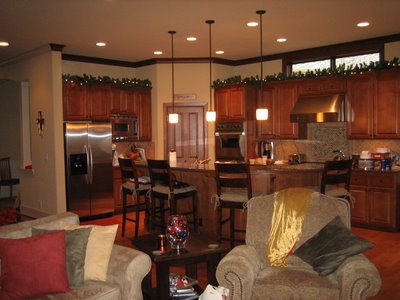

A snowy day in Issaquah:

Friday, December 01, 2006
Cone-y Island

http://www.youtube.com/watch?v=S8bOzijedBU
Tuesday, November 28, 2006
A cold and snowy day in Seattle
The day dawned cold and frosty. For those of you keeping score, this picture of the sunrise was taken at 8:56 AM when the sun was just coming up.

Sue dusted off the snow shovel and gave it a go. This picture of Sue was taken at 1PM and the sun was approaching the horizon... we get sunset around 3pm. This is exaggerated by the mountains around us, but it is still a pretty short day.


Saturday, November 11, 2006
What 10,000 cubic feet of water per second looks like
Thursday, November 09, 2006
My Life in the Junk Shops
I'm coming to the realization that my childhood is now officially classified as "antique". Every shop we'd wander into, I'd find myself saying... "hey, we used to have one of those in our house....". Two notable cases stopped me in my tracks....
Number 1) The Fisher Price Barn, complete with all animals and a "mooooo" sound when you opened the door:

Number 2) the exact same table and chairs that we have painted with our names (well, my name anyway...:)




